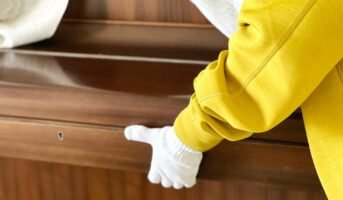A leaky shower faucet can cause hazardous mould or wood decay in addition to wasting water and increasing water bills. By following some simple tips, you can fix the leak manually. The aim of this article is to assist you with repairing the faucet.
Fixing a leaky shower faucet: Steps to be followed
Turn off the water supply to the shower
- Before beginning, one must turn off the water in the shower. You can use the shower’s shut-off valve if it has one. If not, then you may have to turn off the water to the entire house. If this is the case, you should notify everyone in the house that they will be without water for an extended period of time.
- It’s important to test which valve is producing the leak. Turn on and off both the hot and cold water lines to determine which line is causing the problem.
- Remember to cover the shower floor and drain with a towel or cloth. You’ll be dealing with numerous little components. Tools that are dropped can cause harm to the bath, so you don’t want to lose anything. Open all shower faucets to allow any surplus water to drain.
Remove the shower faucet
- Shower faucets are constructed differently. This may have an impact on the process of removing yours. When disassembling the faucet, remember to keep the pieces organised so that you can reassemble them later.
- Remove the cover cap from the shower handle (if there is one) with a flathead screwdriver. If there is a screw under the cap, remove it and set it aside. Remove the handle by loosening it.
Pull out the shower faucet cartridge
A cartridge is used to operate a single-handle shower tap. Using a deep-hole socket wrench, grab onto the nut at the bottom of the metal stem. Screw the nut off and set it aside. Remove the cartridge. To remove the cartridge, use needle-nose pliers to loosen it. If you’re having difficulties taking the cartridge out, one can use a cartridge puller to help.
Pull out the shower faucet stem
- Instead of cartridges, a shower with two or three handles will feature metal stems under each handle. If there are two handles, one should be chilly and the other hot. The third handle (in the middle) controls the bathtub diverter if there are three.
- If one has a multiple-handle system, remember from the start to test which one isn’t working before turning off the water supply. Feel for the dripping water. If it’s cold, the cold water handle isn’t working properly. The hot water handle isn’t working if the water is heated. If water is coming from the diverter, the fault is with the middle handle.
- As with removing a cartridge, it requires a deep socket screwdriver to unscrew the valve nut at the bottom of the stem. One can, however, carefully draw the stem out without loosening it. You will need to remove the stem from each handle you’re repairing.
Inspect for components to replace
When you’ve successfully removed the cartridge or stem, inspect the minor bits to see what needs to be replaced. Some things to look out for are:
- Normal wear and tear or rust signs
- If any washers are bent to one side or affected (metal washers warp more easily than rubber washers due to water)
- If the O-ring is damaged or bent, replace it.
- Other components, such as the sleeve and base nut, should be examined to see whether they are worn.
Keep in mind that any replacement parts must be the same size as the previous ones. If the actual stem or cartridge is damaged or warped, you may need to replace the entire thing. You’ll need the same model if you do. Take the equipment to the hardware store or take a picture of it to ensure that you obtain the correct piece.
Soak the components in white vinegar
Natural mineral deposits build up in portions of your tap when you shower, causing damage and lowering the water pressure. That’s why it’s a good idea to soak any items that you intend to reinstall in white vinegar for eight hours. The vinegar destroys the natural buildup and extends the life of the faucet. This is not necessary with fresh parts (new cartridges, stems, or other components).
Reinstall the shower faucet
- After it’s been replaced everything that has to be replaced, it’s time to reinstall the faucet. Replace the faucet’s parts. If the faucet has a locking clip or bushing, make sure to replace it. Water can be kept out of connected parts by using piping thread sealant. To protect a faceplate from leaks, apply the plumber’s putty or caulk before reinstalling it.
- After having reassembled everything, it’s time to test the faucet. Allow the water to run and check to see if the faucet is still leaking. Remember that pipe thread sealant takes about a day to dry. You will have to postpone testing if you utilise it.
FAQs
How to reassemble the faucet after fixing the leak?
Reattach the faucet and other components in the reverse order of disassembly. Make sure everything is sung but not over-tightened.
What if the cartridge is causing the leak?
Remove the cartridge from the valve body using pliers or a cartridge removal tool. Install a new cartridge that matches the faucet model.
How to replace a worn-out O-ring or washer?
Disassemble the faucet to reach the O-ring or washer, remove the old component, and replace it with a new one of the same size and type.
What causes a shower faucet to leak?
Leaky shower faucets are often caused by worn-out or damaged seals, O-rings, cartridges, or valve components within the faucet assembly.
How to know that the shower faucet is leaking?
If one notices water dripping from the showerhead or faucet when it’s turned off or if one hears a constant dripping sound, the shower faucet is likely leaking.
| Got any questions or point of view on our article? We would love to hear from you. Write to our Editor-in-Chief Jhumur Ghosh at [email protected] |
Housing News Desk is the news desk of leading online real estate portal, Housing.com. Housing News Desk focuses on a variety of topics such as real estate laws, taxes, current news, property trends, home loans, rentals, décor, green homes, home improvement, etc. The main objective of the news desk, is to cover the real estate sector from the perspective of providing information that is useful to the end-user.
Facebook: https://www.facebook.com/housing.com/
Twitter: https://twitter.com/Housing
Email: [email protected]












